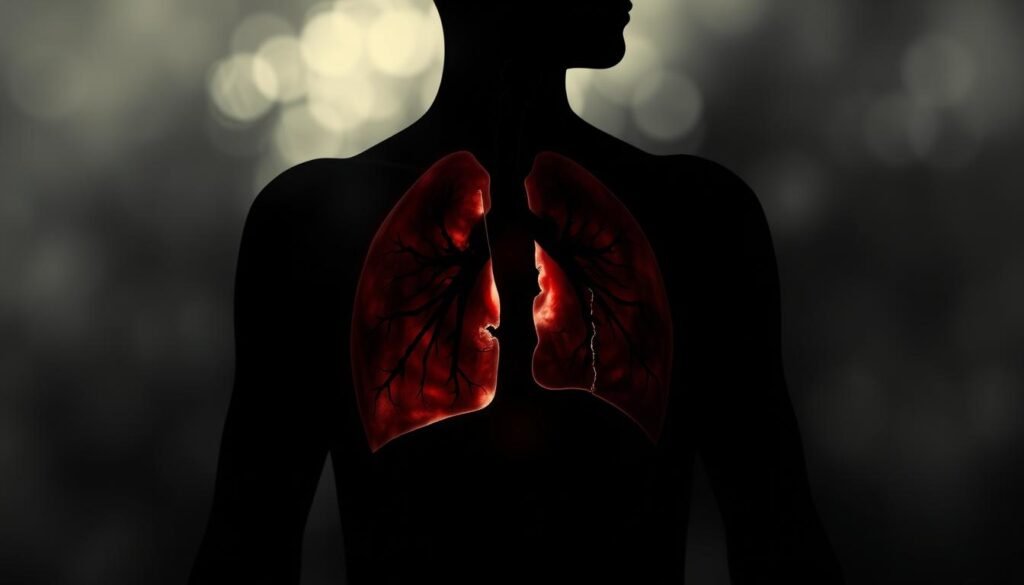Did you know that 20% of lung cancer cases are found at stage four? This fact shows how vital it is to recognize symptoms of stage four lung cancer early. It can make a big difference in a patient’s life. By then, cancer has spread beyond the lungs, leading to more serious issues and signs that vary in how severe they are.
Some common late stage lung cancer symptoms are a persistent cough, feeling short of breath, and losing weight without trying. It’s key for patients and their caregivers to understand these signs. This knowledge helps with managing treatment and offering emotional support. Plus, knowing what lies ahead can aid in arranging palliative care, so patients get the compassionate care they deserve in their last days. For more information on what to expect, check out this comprehensive guide.
Key Takeaways
- 20% of lung cancer cases are diagnosed at stage four.
- Persistent cough and shortness of breath are key indicators of late stage lung cancer symptoms.
- Understanding advanced lung cancer signs can help patients manage their symptoms effectively.
- Early detection is critical, as many lung cancer symptoms are not evident until the disease is advanced.
- Patients in the final stages may require palliative care to enhance their quality of life.
Understanding Stage Four Lung Cancer
Stage four lung cancer is also known as metastatic lung cancer. It is the most advanced stage of this disease. Cancer cells have spread from the lungs to other parts of the body like bones and the brain. This stage focuses on controlling the cancer and managing symptoms.
There are two sub-stages of stage four lung cancer: 4A and 4B. Each has different characteristics that affect treatment decisions. The TNM staging system helps to evaluate lung cancer. It looks at tumor size, if lymph nodes are involved, and if cancer has spread.
The treatment for lung cancer changes based on its type. Non-small cell lung cancer may be treated with drugs, immunotherapy, chemotherapy, or radiation. Small cell lung cancer is often treated with chemotherapy and immunotherapy. Sometimes, radiation is used to prevent brain metastases. The treatment plan also depends on the patient’s health and how far the cancer has spread.
Indicators of advanced lung cancer include new symptoms. Doctors use X-rays, CT scans, and PET scans to check tumor size and location. Tissue biopsies help confirm if cancer has spread by checking for cancer cells. It is crucial for patients and families to talk about treatment and care goals in this stage.
Main Symptoms of Late Stage Lung Cancer
Late-stage lung cancer brings several end-stage lung cancer manifestations. These greatly affect patients’ lives. Knowing these symptoms is key to help manage the disease and boost patients’ life quality.
Common Physical Manifestations
People with symptoms of stage four lung cancer face many challenges. They often report symptoms such as:
- Persistent cough
- Coughing up blood or rust-colored sputum
- Chest pain
- Hoarseness
- Loss of appetite
- Unexplained weight loss
- Shortness of breath
- Fatigue
- Frequent infections such as bronchitis and pneumonia
- Wheezing
These symptoms become more common as the cancer grows. Some people may spot early signs leading to quick diagnosis. But, many don’t see symptoms until the cancer is quite advanced.
Impact of Cancer on Daily Life
Late-stage lung cancer symptoms make daily life hard. Patients struggle with simple tasks or need help with personal care. Their decreasing strength often leads to emotional and psychological distress. This greatly lowers their quality of life.
| Symptom | Impact on Daily Life |
|---|---|
| Persistent Cough | Interferes with conversation and intimacy |
| Shortness of Breath | Limits mobility, causing fatigue and anxiety |
| Weight Loss | Can lead to weakness and decreased physical capability |
| Loss of Appetite | Affects energy levels, further inhibiting daily functions |
Understanding these end-stage lung cancer manifestations helps caregivers and loved ones support those facing late-stage lung cancer challenges.
Symptoms of Stage Four Lung Cancer
Stage four lung cancer includes alarming symptoms. These heavily impact life quality. The common experience is a persistent cough. This cough might mean there’s a blockage caused by tumors. It tends to get worse, showing the cancer is advancing. For many, this cough is more than just annoying. It suggests significant health shifts that need quick attention.
Persistent Cough and Its Implications
A constant cough is a key warning for stage four lung cancer patients. It can come with worrying signs, like coughing up blood. This shows the disease is moving forward fast. Coughing up blood is scary and needs a medical check-up right away. It’s crucial for patients to see this as a serious part of their health condition.
Shortness of Breath and Fluid Build-Up
Many with this cancer also have shortness of breath. This makes daily tasks hard. Often, this is due to fluid around the lungs, known as pleural effusion. This problem is common in late-stage cancer. Doctors may need to remove this fluid. This helps make breathing easier and improves comfort.
Significance of Coughing Up Blood
Coughing up blood is serious. It shows big changes in the lungs. It might mean the cancer is getting worse fast. This is a key sign that the disease is advancing. Knowing this helps patients and families get help fast. This way, they can change their treatment if needed.
Advanced Lung Cancer Signs: What to Look Out For
It’s crucial to know the signs of advanced lung cancer for early detection and treatment. Two main signs are significant weight loss and overwhelming fatigue. These affect both the body and the quality of life significantly.
Weight Loss and Loss of Appetite
As cancer gets worse, weight loss becomes more noticeable. Patients often eat less due to the body’s needs and treatment side effects. This leads to cancer cachexia, with severe weight loss, muscle wasting, and extreme tiredness. Early recognition of this can help in providing necessary care for terminal lung cancer indications.
Fatigue and Muscle Wasting
Advanced lung cancer often brings chronic tiredness. This makes daily tasks hard for patients. Loss of muscle makes the tiredness worse, making it hard to stay strong. This cycle increases the need for caregiver support and highlights the need for palliative care.
Discover more by exploring advanced lung cancer signs and what they mean.
Terminal Lung Cancer Indications and Pain Management
People with terminal lung cancer often face a lot of pain. This pain can make their lives very hard. Effective pain management in advanced cancer means knowing where the pain comes from. It could be from the cancer or from it spreading.
Identifying Pain Sources
Many with lung cancer feel pain from bone spread, pancoast tumors, or chest issues. Knowing where the pain starts is key to help them feel better. Most cancer patients, about 75%, deal with ongoing pain. This pain can be nociceptive, from body damage, or neuropathic, from nerve damage. Sometimes, even with good pain treatment, sudden severe pain can happen.
Treatment Options for Pain Relief
There are many ways to help ease pain for those with terminal lung cancer. The World Health Organization has a guide called the Analgesic Ladder. It suggests starting with non-opioids, like paracetamol and anti-inflammatory drugs. If the pain is strong, doctors might give weak opioids, like codeine, or stronger ones, like morphine. Studies show that opioids do not change how long a patient lives.
Pain relief drugs include acetaminophen, ibuprofen, morphine, and oxycodone. Doctors also use other meds, like antidepressants and anticonvulsants, to help. Seeing a palliative care team early can lead to better pain control. This was true for 85.4% of patients checked early. It’s important to keep checking and tweaking how pain is managed as things change. Good pain management means a better life for those with lung cancer.
Recognizing symptoms early leads to better treatments and outcomes for patients.
Emotional and Psychological Changes in Patients
Patients with stage four lung cancer often face big emotional shifts. They might feel mood swings, pull away emotionally, and deal with frustration. As they deal with their diagnosis and treatment, they find it hard to stay positive and social.
Understanding Mood Swings and Emotional Withdrawal
These patients can feel overwhelmed by not knowing what will happen next. They worry about how treatment will affect them and their families. This can make them very anxious and stressed. Studies show that many patients feel emotional distress during chemotherapy. Getting psychological support is key to helping them through these tough times.
Importance of Mental Health Support
It’s very important to support the mental health of lung cancer patients. Counseling and joining support groups can lessen their feelings of being alone and sad. Things like talking it out, calming strategies, and sometimes medicine can help them cope. Those with a history of mental health issues do better with social support. So, making sure these patients get the help they need is crucial. For more information, check out this study.

Recognizing Neurological Symptoms
Lung cancer can spread beyond the lungs leading to brain issues. It’s important to notice signs like severe headaches, seizures, and confusion early. These signs mean we need to act fast with the right care.
Headaches and Seizures from Brain Metastases
When cancer reaches the brain, headaches and seizures may become common. These signs can make daily life hard and show the cancer is affecting the brain. Knowing these signs early can help choose better treatments and improve life quality.
Confusion and Cognitive Impairment
Confusion and trouble thinking can also happen as cancer grows. These issues can make talking and doing everyday tasks difficult. Handling these problems is key to helping maintain quality of life during treatment.
Physical Changes in End-Stage Lung Cancer
In advanced stages of lung cancer, patients go through major changes. These changes can greatly affect their daily life. End-stage symptoms often lead to severe weakness, making it hard to move around. Due to this, they might need help with simple tasks like bathing and dressing. Caregivers are crucial in making sure patients are comfortable during this tough time.
As the disease gets worse, losing appetite is common. Patients may not feel like eating and might have difficulty swallowing pills. To help, caretakers can give medicine in liquid form or use a pain patch. It’s important to remember their dietary needs decrease. They may not need as much food or water.
Respiratory problems become more noticeable. This can lead to a distinct rattling sound when breathing. Even though this may not bother the patient, changing their position often can help with comfort and blood flow. Caregivers should do this every one to two hours.
Poor circulation is another issue, causing cold hands and feet, dark skin, and irregular heartbeat. As breathing becomes more difficult, some may stop breathing for short periods. To help, keep them warm and offer comfort. This can make them feel more secure during their last days.
In the final stages, patients may have trouble seeing clearly or hearing. Understanding these progressive cancer symptoms is vital for caregivers. This allows them to provide the right kind of support. Unfortunately, the survival rate for those diagnosed with late-stage lung cancer is low. This highlights the need for compassionate care at the end of life.

| Physical Change | Potential Symptoms | Care Strategies |
|---|---|---|
| Weakness | Difficulty moving around | Assist with daily activities |
| Loss of Appetite | Decreased desire for food | Offer liquid medications |
| Respiratory Issues | Rattling sounds while breathing | Maintain frequent position changes |
| Circulation Changes | Cool extremities | Keep the patient warm |
| Sensory Changes | Blurry vision, decreased hearing | Provide gentle reassurance |
Worsening Lung Cancer Presentation: The Final Stages
As lung cancer gets worse, patients may have trouble breathing. This can be hard for them and their families. Knowing about these symptoms helps provide loving care in the last days.
Changes in Breathing Patterns
Breathing gets irregular in lung cancer’s final stages. People might breathe fast at times. Then, they might take shallow breaths with pauses in between. Breathing becomes harder, even when they’re sitting still.
- Periods of rapid breathing.
- Shallow breaths alternating with longer pauses.
- Increased difficulty with normal breathing even while at rest.
This shows the lungs are not working well. It means the body can’t keep going much longer.
Skin Changes and Temperature Fluctuations
Skin changes also happen with advanced lung cancer. Signs include:
- Coolness of the skin, especially the hands and feet.
- Skin that looks mottled or pale, showing poor blood flow.
- Body temperature that goes up and down, causing fever or chills.
These skin changes can upset families. It’s key to know what will happen as a loved one gets sicker.
Metastatic Lung Cancer Symptoms and Impacts
People with metastatic lung cancer face many symptoms. These symptoms change their life quality a lot. The type of symptoms depends on where the cancer has spread. Bone pain is a common symptom if the bones are affected. This pain can make moving and daily tasks very hard. Managing this pain well is important.

Bone Pain and Other Metastatic Effects
Besides bone pain, lung cancer can cause other serious issues. If cancer reaches the brain, it might cause headaches, seizures, or thinking problems. When the liver is affected, jaundice might happen. This shows the liver is in big trouble.
Noticing these symptoms early is key to getting the right care. There are many treatments, like chemotherapy and special care to improve life quality. This approach helps with both physical symptoms and emotional support. It helps those dealing with this tough condition.
Conclusion
It’s vital to know the signs of stage four lung cancer for timely care. This knowledge helps individuals and families seek the right treatment quickly. Early detection is key to better treatment outcomes.
Symptoms like ongoing cough, chest pain, and trouble breathing suggest lung cancer may be advancing. Knowing these signs allows people to get ahead by talking to doctors early. Sadly, less than half of those at high risk get screened soon enough.
When facing the end of life, it’s all about keeping a good quality of life. Support for both patients and their caregivers is crucial. Although lung cancer’s journey is tough, being informed helps in making wise choices during hard times. For details on early signs, check out this guide.